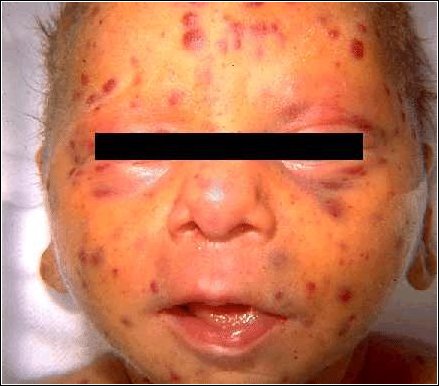Rubella Virus
This virus is the only member of the genus Rubivirus of Togaviridae. Also known as German Measles, this virus is usually characterized by a mild disease in both children and adults with a red maculopapular rash. Infection of the fetus however, results in severe disease, especially if infection occurs within the first few weeks of pregnancy.
Transmission: Respiratory route (not arthropod-borne unlike most of the Togaviruses)
Epidemiology: Man is the only host and the virus is seen worldwide. Periodic epidemics affect unvaccinated populations. Natural infection incurs life-long immunity.
Infection: Infection usually begins in the upper respiratory tract. The virus replicates locally in the epithelium and lymph nodes and then proceeds to spread to other tissues.
Incubation period: ~2 weeks (12-23 days)
Disease presentation:
 |
Children and Adults: symptoms include low grade fever,
sore throat, rash, and lymphoadenopathy. In extremely
young children there is usually no prodrome. The rash, if
it occurs at all, occurs after the incubation period and
begins on the face, lasting between 12 hours and 5 days.
People are usually infectious one week before the
appearance of the rash to one week after the rash
disappears. Adults can also get arthralgia and sometimes
arthritis. Rare complications can include encephalitis in
less than 1/5,000 cases, neuritis, orchitis, and panencephalitis.
|
Fetus: The risk of sever disease in neonates is the highest if the mother is infected within the first few weeks of pregnancy and declines as the pregnancy progresses. The virus first infects the placenta and then proceeds to infect the fetus. The affects of infection include the follow:
Hearing loss (most common), Congenital Heart Defects, Ophthalmic problems, Intrauterine growth retardation, Neurological Problems including mental and psychomotor retardation as well as microcephaly, Hepatomegaly, Splenomegaly, Bone lesions, Thrombocytopenia purpura, and pneumonitis.
If the mother is non-immune and is infected within the first trimester, up to 80% of the neonates have sequelae.

Source: American Academy of Pediatrics
Prevention: A live-attenuated vaccine is available that incurs life-long immunity. This vaccine is often given in as a trivalent vaccine with measles and mumps and varicella has recently been added to this vaccine.
Treatment: No specific treatment, just supportive care.

